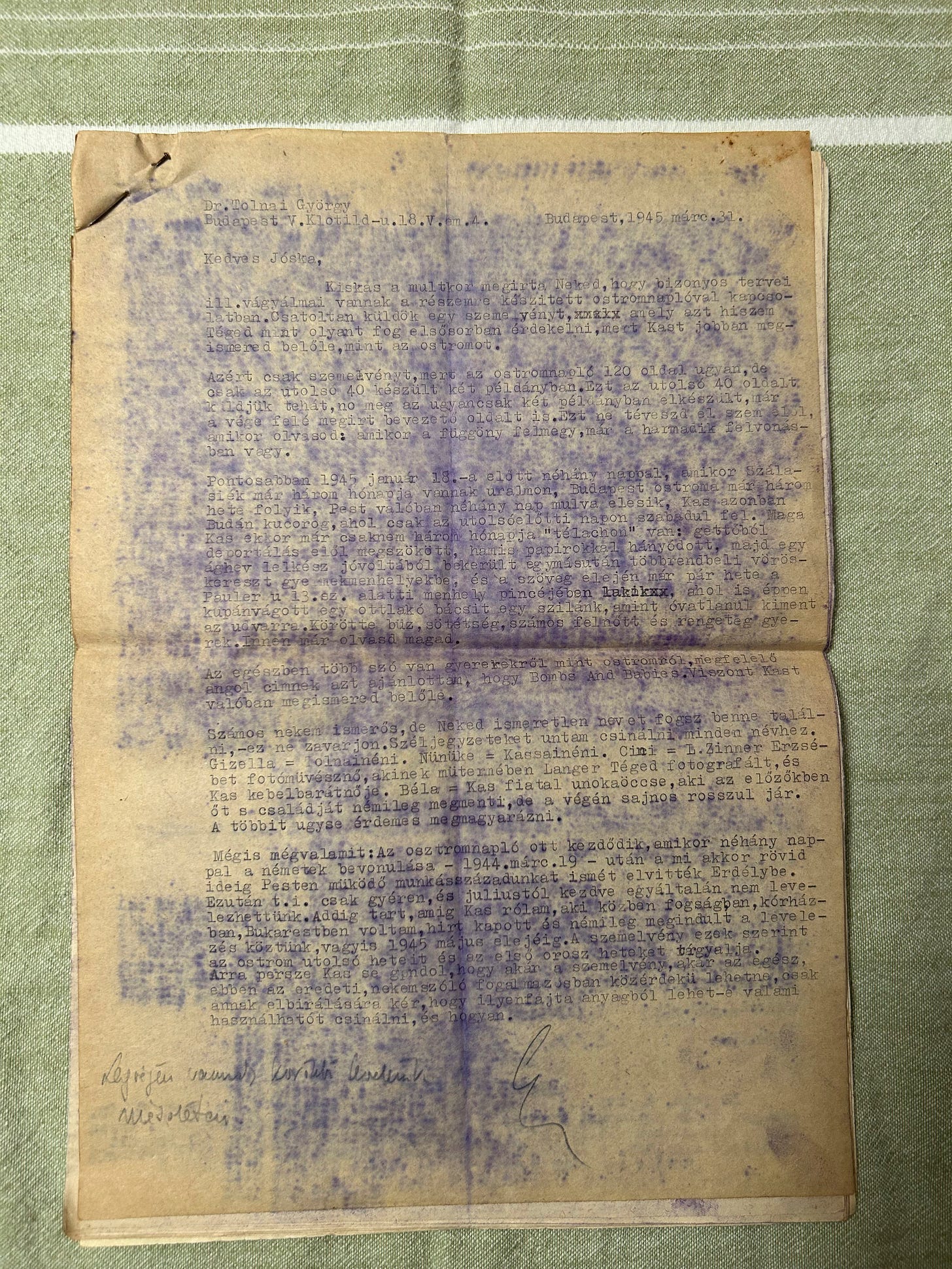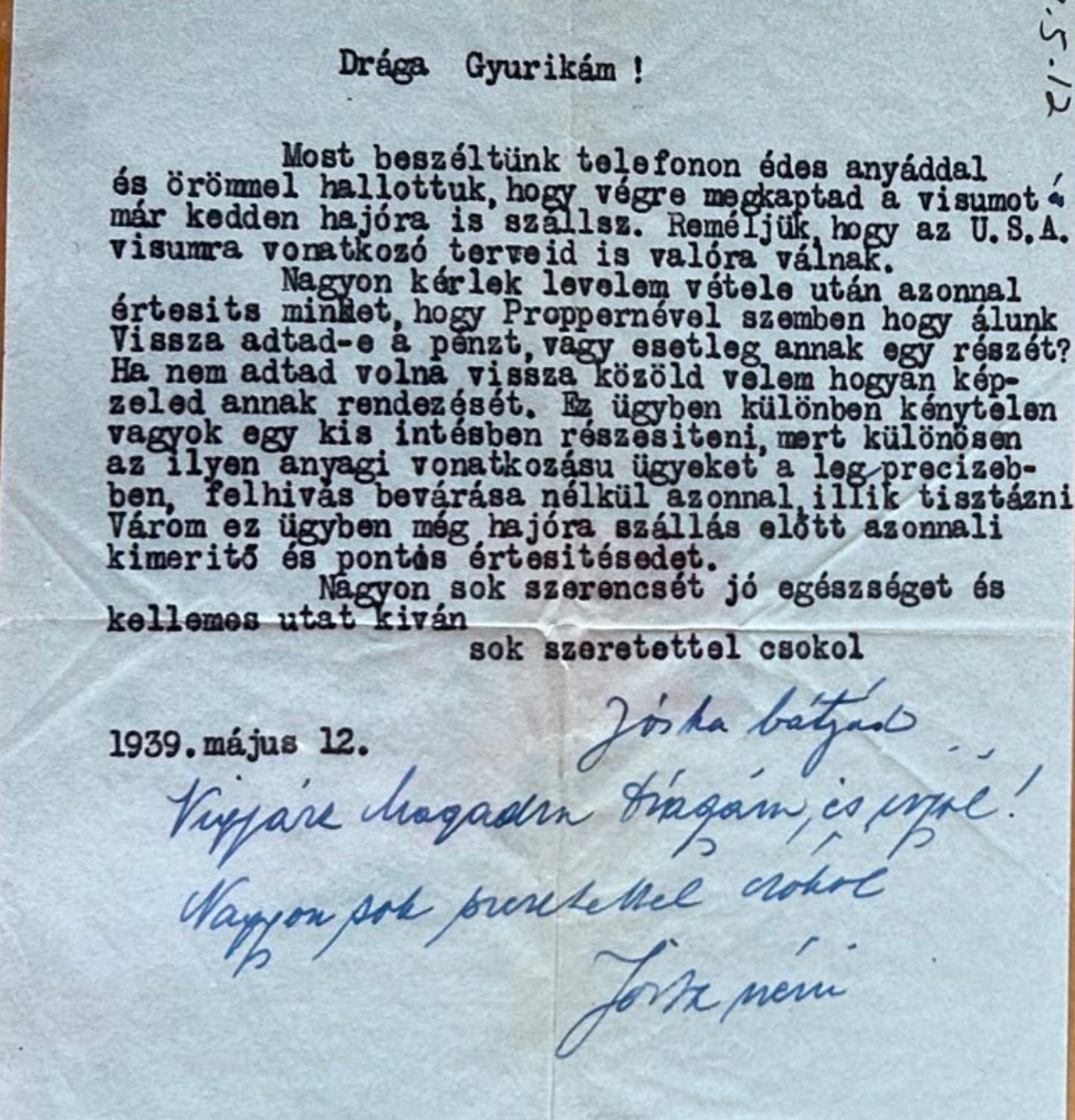A new mystery emerged over the weekend.
Over the summer, I photographed hundreds of documents in the Gerbner family archive. Since then, I have been working with a Hungarian translator to summarize or translate the letters, newspaper clippings, notebooks, and other miscellaneous papers that my grandparents kept and collected. There are a lot of materials.
A few days ago, I asked my translator to look through this 42-page typewritten document which, as you can see, is in pretty bad shape:
My translator skimmed the document, and said it was a diary about the siege of Budapest, which occurred near the end of World War II, from Christmas eve 1944 until February 1945. This was when Russian troops closed in on the Hungarian capital which was, at the time, controlled by the fascist Arrow Cross government, run by Ferenc Szálasi.
The full diary is 120 pages, but Opapa only had the last 42 pages. The diary itself offers a first-person narrative of the seige in stunning detail and is written by someone named “Kas” or “Kiskas.” The excerpt we have begins “a couple of days before January 18, 1945, when Szálasi and his party have been ruling for three months already, the siege of Budapest have been on for three weeks already.”
The author, “Kas” or “Kiskas,” has been in hiding “for almost three months: she escaped from the ghetto so that she would not be deported, she has wandering around with forged papers, when with the help of a Lutheran priest she could get into various children’s shelters managed by the Red Cross.”
The seige diary is composed of letters from Kiskas to her husband, who “was forced into Jewish labor service in April 1944.” Kiskas stated that “her reason for writing down the events of the previous year in March 1945 was to inform her husband of her experiences in order to fill the gaps caused by their separation.”1
This is fascinating, but I have no idea who this author is, and I don’t think it’s anyone in my family.
How and why did Opapa have this document? And what does it mean?
I did a little research, wondering if this diary was already published, or whether there were other copies. My initial searches turned up nothing. But then I found an article, published in 2014, that seemed to be referring to the same diary. Written by a Hungarian historian named Gergely Kunt and titled “Ironic Narrative Agency as a Method of Coping with Trauma in the Diary-Memoir of Margit K., a Female Holocaust Survivor,” the article is an analysis of a diary about the seige of Budapest written by someone who “refers to herself as Kiskas [‘Little Hive’], a nickname used by her and her husband.” According to Kunt, there is a copy of the full manuscript “in the Budapest Collection of the Szabó Ervin Library in Budapest under call number BQ 0910/374.”
This is definitely the same diary. The author of the article, Dr. Kunt, has found “Kiskas’s” real name, though he does not reveal it. Instead, he calls her “Margit K.”:
Margit, author of the typescript examined in this paper, was a thirty six-year-old Jewish woman living in Budapest during World War II, and in accordance with the Hungarian Data Protection Act, her anonymity shall be preserved by the use of her given name and the initial of her surname only.2
Interestingly, however, Kunt is unable to identify Kiskas’s husband. As he writes:
Unfortunately, we do not know the name of Margit’s husband to whom she dedicated her typescript as she always addressed him by his nicknames, Pippancs [‘Peepkin’] or Kispipi [‘Little Peep’] and only mentions that her husband attended the Fasor Evangelical [Lutheran] High School. Neither do we know when he was baptized, but he was originally classified as an Israelite by the Anti-Jewish laws and may have been the influence behind Margit’s turn to the Evangelical [Lutheran] faith.
Well, it turns out that the mystery manuscript in Opapa’s collection, somewhat miraculously, reveals the name of Kiskas’s husband.
Opapa’s version of the diary, while only containing 42 pages, begins with a letter that is not included in the version of the diary that Kunt discovered. The letter (pictured above) is addressed to someone named Jóska, a nickname for Jószef. It was from Dr. György Tolnai, who lived at Budapest, V. Klotild utca 18. V. floor 4, and dated March 31, 1945: just 6 weeks after the seige was over, and before the official end of World War II.
From the letter, it is clear that the author of the letter — Dr. Tolnai György — is Kiskas’ husband. Here is how he begins:
Not long ago, Kiskas wrote to You that she has certain plans or desires regarding the siege diary that she has prepared for me. Enclosed I am sending an excerpt which I think you will be interested in as from it you will get to know Kas better than the siege.
Dr. György Tolnai to Jóska, March 31, 1945
Tolnai also reveals the true names of the other people in the diary:
You will find several names in the story that I am familiar with, but which are unknown to you – do not get distracted by these. I could not get myself make notes on the margins for each name. Gizella = Mrs. Tolnai (Tolnai néni). Nünüke = Mrs. Kassai (Kassai néni). Cini = L. Zinner Erzsébet photographer, in her studio Langer took pictures of you, and she is good friends with Kas. Béla = Kas’s young nephew who previously kind of saved her and her family as well, but he gets unlucky in the end. The rest is not worth explaining.
Wow. We get a lot of important information from this letter. I haven’t had time to find each of these individuals, but I did find Erzsébet Zinner, a Hungarian photographer. You can see hundreds of her photographs here.
The remaining question, of course, is why Opapa had this letter and this manuscript. How was he connected to the recipient of the letter, someone named “Jóska,” aka Jószef?
I am still not sure, but currently, I have one guess: I think Jóska may have been Opapa’s uncle. Árpad’s sister, Jósza, was married to someone named Jóska. In 1939, Uncle Jóska had sent Opapa a letter regarding Mrs. Troper (Aunt Jósza’s friend) and the whole oceanliner affair. Here, he signs his letter to Opapa “Jóska Bátyád,” or “Uncle Jóska.”
If Uncle Jóska was the recipient of the manuscript, the next question becomes: why?
It seems, from Tolnai’s letter, that Kiskas (Margit K.) was hoping to publish her seige diary. Here is how Tolnai concludes his letter to Jóska:
Of course, even Kas herself does not expect that either the excerpt or the whole text could be shown to the public in its original version that was written to me, she only asks you to examine whether if anything useful could be prepared from such a material and how this could be done.
Was Jóska in publishing? Was he friends with György Tolnai?
As I try to untangle this story, I have also written to Gergely Kunt, to share Opapa’s version of the manuscript, and to see if he has any ideas about this mystery.
To be continued!
***
Nuts to crack:
Were there any other people named Jóska, aside from “Uncle Jóska,” that Opapa knew in Budapest in 1945-6?
What was Uncle Jóska’s last name, and what was his profession?
Who are the other people mentioned in the seige diary?
Who is György Tolnai?
Gergely Kunt, “Ironic Narrative Agency as a Method of Coping with Trauma in the Diary-Memoir of Margit K., a Female Holocaust Survivor,” p. 29
Gergely Kunt, “Ironic Narrative Agency as a Method of Coping with Trauma in the Diary-Memoir of Margit K., a Female Holocaust Survivor,” p. 29






WOW, what a fascinating mystery and impressive detective work!
Very interesting. Omama talked about the siege, sounded pretty horrible. Russians shelling from the hills by day, Americans bombing from the air by night.
The whole time spent in the basement.